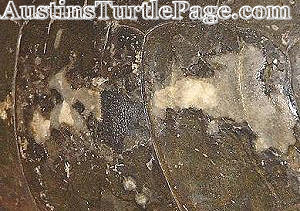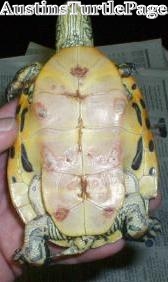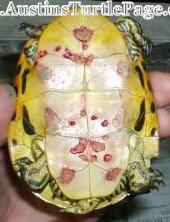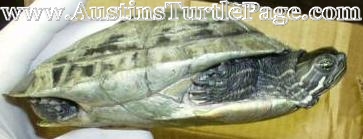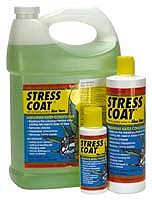|
|
|
|
||
|
This portion covers the following symptoms and medical situations:
|
||||
|
|
|
|
|
|
|
||||||||||||||||
Wet SCUD This is either bacterial infection or fungal infection. This is usually the result of a crack, break, cut or other type of lesion in the shell that has become infected. The typical cause for a fungal infection is the turtle being unable to get completely dry. This condition is usually white and/or yellow, smells really bad, and is squishy with pussy discharge not uncommon. Untreated, it can quickly progress into septicemia. Dry SCUD The most common causes of this condition are water quality and injuries, albeit minor at times, from habitat decorations (scratched while climbing, swimming or diving into the water, substrate, heater burns, etc). It appears most times as white patches on shell. The treatment (below) is similar to that of the wet form of SCUD, while serious infections will require the addition of systemic medications. Better results have been gained from keeping the turtle in the alternate treatment (described above) with the water treated with Acriflavine as well. Frye (1991) shows that pathogens that can cause SCUD can be carried by shrimp. Another VERY effective treatment is the use of Silverdyne (Silver Sulfadiazine) Cream. This is a prescription medication that is used to treat human burn victims. It is very effective. Mineral Deposit Buildup This condition is commonly confused with Shell Rot and shell bacterial growth. It is difficult to discern the difference between the two, and the identifying features that are used to assist in determining the two apart or confusing and sometimes inconclusive and misleading. The only way to verify that a condition is true Shell-Rot or bacterial in nature, is to have it tested to verify the presence of organic material.
This is caused from having water that is heavy with minerals. A key feature to mineral deposits is that the scutes will be clear underneath, and this will be evident once the turtle sheds. There will be a white-to-off-white coating or glazing over the scutes. There will be no pitting and if pitting is present, it may be light or there might be a bacterial infection present as well.
Remove turtle and place in a quarantine tank. The infected areas should be cleaned and, if need be, affected scutes removed to ensure effective treatment underneath. Remove all squishy, off-white colored material. Be careful as the infection may have gone deep. Going too deep may cause you to penetrate into the body cavity. If you see that you will have to go more then a little bit past the surface of the shell, stop and seek veterinary assistance. Listed below is a regimen that I have followed in treating shell problems and has yielded great results. Keep in mind that shell injuries will take months and sometimes years to get back to looking normal if the possibility exists. It takes weeks before the shell will look like it's getting better. While treating, you are not looking for signs of healing or repair - you are looking to ensure that it is not spreading.
This treatment performed daily or twice daily, depending on your time allocation, has been successful in as few as 8-10 days but in more extreme cases can take a few weeks. It is difficult to tell success right away, so it is often discouraging. It is, however, quite effective and you will begin to see small improvement (in most cases) in only a few weeks. NOTE: The betadine bath's 'weak tea' solution is not advised as this can potentially bring about health issues later on. Treatment using Acriflavine Acriflavine is one of the greatest meds to use with turtles. I have treated shell infections with numerous medications and methods, but Acriflavine has given me better and faster results. This is my treatment method:
At this point, do 50% water changes for the next few weeks, and then taper back down to your normal routine. This will not only assist in fighting off anything that is trying to re-establish itself in your turtle's home, but also helps in general with water quality until the turtle has had proper time to heal.
|
||||||||||||||||||
|
|
|
|||||||||||||||||
|
|
|
|
|
If the shell is bleeding, then it would most likely be a good idea to take it to a qualified vet as soon as possible. If the injury is not very serious, then treatment at home is fairly simple.
If the turtle is bleeding excessively or there are caved-in portions of the shell, take to a vet immediately Remove turtle and place in a quarantine tank. Clean the injured area with clean water. Disinfect the area with iodine or betadine. Treat with Neosporin or triple action antibiotic. Let turtle be dry for about an hour after treatment. Place in separate tank with clean water. You can add StressCoat for fish as it assists in the healing process. Treat this way daily for about 2 weeks or so. |
||
|
|
|
|
|
|
|
|
This will appear as, but not be limited to, excessive shedding skin, sores and sometimes a general foul smell. This condition, left untreated, can result in septicemia.
Before being able to affectively treat the turtle, the root cause of the infection must be determined. Generally, skin infections come about due to inadequate filtration. Ensure that you place a quality filter in the turtle's habitat and use the recommended filter media. This will go along way in prevention. Treatment using Acriflavine Acriflavine is one of the greatest meds to use with turtles. I have treated shell infections with numerous medications and methods, but Acriflavine has given me better and faster results. This is my treatment method:
At this point, do 50% water changes for the next few weeks, and then taper back down to your normal routine. This will not only assist in fighting off anything that is trying to re-establish itself in your turtle's home, but also helps in general with water quality until the turtle has had proper time to heal. |
||
|
|
|
|
|
|
|
|||
|
Remove turtle and place in a quarantine tank. The infected areas should be cleaned and, if need be, affected scutes removed to ensure effective treatment underneath. Remove all squishy, off-white colored material. Be careful as the infection may have gone deep. Going too deep may cause you to penetrate into the body cavity. If you see that you will have to go more then a little bit past the surface of the shell, stop and seek veterinary assistance. Listed below is a regimen that I have followed in treating shell problems and has yielded great results. Keep in mind that shell injuries will take months and sometimes years to get back to looking normal if the possibility exists. It takes weeks before the shell will look like it's getting better. While treating, you are not looking for signs of healing or repair - you are looking to ensure that it is not spreading.
This treatment performed daily or twice daily, depending on your time allocation, has been successful in as few as 8-10 days but in more extreme cases can take a few weeks. It is difficult to tell success right away, so it is often discouraging. It is, however, quite effective and you will begin to see small improvement (in most cases) in only a few weeks. NOTE: The betadine bath's 'weak tea' solution is not advised as this can potentially bring about health issues later on. Treatment using Acriflavine Acriflavine is one of the greatest meds to use with turtles. I have treated shell infections with numerous medications and methods, but Acriflavine has given me better and faster results. This is my treatment method:
At this point, do 50% water changes for the next few weeks, and then taper back down to your normal routine. This will not only assist in fighting off anything that is trying to re-establish itself in your turtle's home, but also helps in general with water quality until the turtle has had proper time to heal.
|
|||||
|
|
|
|
|
|
|
|
Most times, this is the result of a cured case of SCUD, fungal infection, or other shell condition. In rare instances, this may very well be another form of a shell condition. Keep an eye on it and begin treatment if the condition worsens. |
||
|
|
|
|
|
|
|
|
Holes appearing in the shell can be the result of injury, infection or dietary neglect. Often times, with a new turtle (not babies), you might begin to see a hole forming as a scute sheds. This is most times the result of poor and importper treatment while in the pet trade. Some holes begin looking like ulcers. This, again, cane be caused by many things, to include infection and diet. It is not uncommon to see blood surrounding the outline of these appearing ulcers.
Ensure that your turtle is getting a proper diet, proper lighting and is basking sufficiently. This is most often the case in assisting them in repairing their problem. It will take some time to look normal, but at least the problem is fixed. Superficial scars are acceptable as long as proper health is returned. |
||
|
|
|
|
|
|
|
|
Seeing red or pink coming through the plastron or going along the scutes of the carapace, usually indicate Septicemia, but not always. It is not uncommon for younger turtles to have a slight pinkish or faded rust-colored appearance on the plastron. This eventually goes away in time and is of no health concern. Having a red or pink tint to the skin can sometimes be an indicator of indicate Septicemia, but not always. Also check the temperature of your habitat's water and basking areas. |
||
|
|
|
|
|
|
|
|
If your turtle is very young, it will have a soft shell, until it hardens naturally. This is not a poor health issue. If your turtle's shell does not harden as it grows, then the turtle's diet needs to be reviewed, as well as the UVB light tested. Soft spots on shell are the result of dietary problems. Ensure that you turtle is getting their species-specific diet. Also be sure that the softening of the shell is not the onset of a fungal infection.
Ensure that your turtle's diet if rich in calcium and that you UVB light is still producing UVB waves. This condition should heal itself without the aid of medications, but if it persists without improvement, a trip to a qualified vet is in order. |
||
|
|
|
|
|
|
|
|
Shedding is a normal part of a turtle's life. They shed both skin and scutes regularly. Scutes that are shed will often appear to lift up on the edges as they begin to release from the shell. Sometimes they will not come loose completely and air will get trapped underneath. This will give a metallic, copper-colored appearance underwater. This is normal. However, if the scute is not shed in an acceptable amount of time (usually a week or so), then you might want to gently assist the turtle in shedding these scutes. Most times, gentle pressure or a gentle brushing with a soft toothbrush will do the trick. Never try to remove a scute that is not ready to be shed. This can cause injury, bleeding and can oftentimes remove too much, leaving the bone and soft tissue open to infection. If your turtle is not shedding properly, then an evaluation of the diet is in order. Most times, failure to properly shed scutes falls back on a lack of vitamins in the diet, mainly Vitamin E. An increase in Vitamin E in their food is required. Turtles will also shed their skin, but not in the way that other reptiles do. Their skin comes off in small and fine quantities and is difficult to see them actually shedding. If you do see your turtle shedding with large clumps or strands of hair-like skin hanging from them, then this is called excessive shedding. Most times when a turtle sheds excessively, it is a sign of over-feeding, water temperatures being too warm, poor water quality, a skin condition, or other infection in the body. A normal "shedding" activity for some species of turtles, is to bite at their legs, peeling off and sometimes eating small layers of skin. |
||
|
|
|
|
|
|
|
|
This is not an uncommon sight in some species. This is your classic skin fungus. Not taken care of, it can enter the blood stream, become septicemic, and destroy certain organs within the body.
Note: The dry-tank method has yielded the highest success rate. Remove turtle and place in a quarantine tank. The infected areas should be cleaned. Be careful when cleaning out the injury as the infection may have gone deep. Going too deep can cause extreme pain to your turtle. Listed below is a regimen that I have followed in treating shell and skin problems and has yielded great results. While treating, you are looking for signs of healing and this may take several days before you can actually see a difference. A good idea is to take a clear photograph before treatment and compare it to another photograph of the same area a few days or a week later.
This treatment performed daily or twice daily, should show you improvements within a week to 10 days. NOTE: The betadine bath's 'weak tea' solution is not advised as this can potentially bring about health issues later on. |
||
|
|
|
